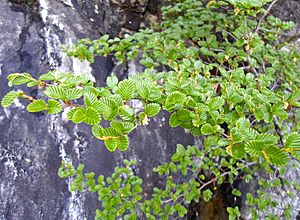Tanglefoot- facts for kids
Quick facts for kids Tanglefoot- |
|
|---|---|
 |
|
| Scientific classification | |
| Genus: |
Nothofagus
|
| Species: |
gunnii
|
| Synonyms | |
|
Fuscospora gunnii (Hook.f.) Heenan & Smissen |
|
The Nothofagus gunnii, also known as the tanglefoot- or deciduous beech, is a unique shrub or small tree. It is found only in the high mountains of Tasmania, Australia. This plant is special because it is one of only two trees in Australia that loses its leaves in winter. It was first found in 1847 by R.C Gunn. Scientists have even found proof that it once grew in Antarctica!
This small woody plant usually grows as a thick shrub. It can reach up to 10 meters (about 33 feet) tall, but it often stays much shorter. It loves cool weather and can live at heights up to 1,600 meters (about 5,250 feet) on mountains. You won't find it near the coast because it needs the colder temperatures of the alpine and sub-alpine areas. Its common name "tanglefoot" comes from its thick, shrubby growth that can be hard to walk through.
Contents
About the Tanglefoot Beech
The tanglefoot beech was first described by a scientist named Joseph Dalton Hooker.
People call this plant by a few names, like tanglefoot beech, deciduous beech, or fagus. The name "fagus" can also refer to the whole Beech family of trees.
Some scientists from New Zealand have suggested a new name for this species: Fuscospora gunnii. However, not everyone agrees with this change, so it is still often called Nothofagus gunnii.
What Does it Look Like?
The Nothofagus gunnii is a small tree that can grow up to 4 meters (about 13 feet) tall. It often looks like a thick shrub because it has many branches. Its leaves are simple and oval-shaped with jagged edges. They are attached by short stems.
The leaves are usually less than 20 millimeters (less than an inch) long and look distinctly "crinkled." This crinkled look helps tell it apart from another Tasmanian tree in the same family, the Nothofagus cunninghamii.
Just like other deciduous plants, its leaves change color in autumn and winter. They are bright green for about 7-8 months. Then, in autumn, they turn a beautiful yellow and then a brilliant red. The leaves are almost round with deep veins that end in the gaps between the rounded teeth.
This plant has separate male and female flowers on the same tree. Both types of flowers are small and hard to see. The fruit is small, about 6 millimeters (0.2 inches) wide, and woody. It holds three small winged nuts. Most years, the plant doesn't make many seeds. But sometimes, it has a "mast" year, producing lots of seeds that can grow easily. These seeds do not stay good for long.
Tanglefoot forests cannot survive fires. If a fire happens, new trees must grow from seeds that come from nearby areas. These trees grow very slowly, so they are sensitive to changes in their environment. Today, less than 100 square kilometers (about 38 square miles) of this forest remain.
The Nothofagus gunnii is one of only two native deciduous trees in Tasmania. It is also one of only two cold-climate, winter-deciduous trees in all of Australia.
Where it Lives
The Nothofagus gunnii is found only on the island of Tasmania. It grows in high places with lots of rain and where there haven't been any recent fires. It was first found on Mount Olympus in central Tasmania. You can also find it in Mount Field National Park and on Cradle Mountain.
Scientists believe this species is very old. They have found fossils of it in Tasmania and even in Antarctica! This shows that it has been around for a very long time.
Growing Tanglefoot Beech
Growing Nothofagus gunnii can be tricky. It needs about 1,800 millimeters (about 70 inches) of rain throughout the year. It also needs cool temperatures, but not colder than -10°C (14°F), and lots of sunshine. It grows best in deep, peaty soils.
The best way to grow it is from fresh seeds collected in a "mast" year. These seeds usually sprout in a few weeks. Scientists think that a special type of fungus, called a mycorrhyzal fungus, is needed for the plant to grow well for a long time. You can also try to grow it from cuttings taken in late winter before new buds appear.
Nothofagus gunnii is not often grown by people because it doesn't grow very well and takes a long time to get big. However, some people think it could be a good plant for bonsai, which is the art of growing miniature trees.
Ecology and Life Cycle
Nothofagus gunnii lives only in the high mountain areas of Tasmania. It usually grows above 800 meters (about 2,600 feet) because it needs cool temperatures and a short period of snow. It can be found as a dominant, low, shrubby tree on open, rocky slopes.
This species is very sensitive to fire and cannot survive burning. Fires have caused this plant to disappear from some areas, like the Denison Range. Even though it grows in a limited area, Nothofagus gunnii is not currently listed as an endangered species.
Not much is known about how Nothofagus gunnii reproduces. However, it is thought that its seeds are carried by the wind. Like similar trees, it probably produces many seeds all at once in a "mast" year.
Images for kids


